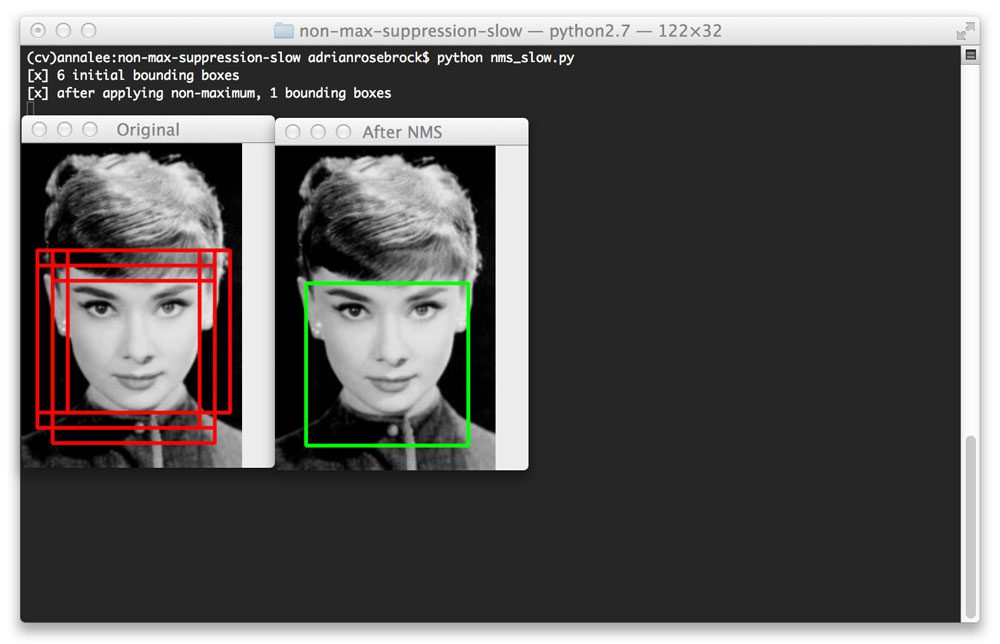Learning non-maximum suppression Jan Hosang Rodrigo Benenson Max Planck Institut für Informatik Saarbrücken, Germany firstname. Non-maximum suppression Non-maximum suppression (NMS) is a crucial component for removing duplicate detections. In addition to traditional NMS, Soft-NMS reduces confidence proportionally to the IoU. The de facto standard for NMS is a simple hand-crafted test time post-processing, which we call GreedyNMS.
One indispensable component is non-maximum suppression (NMS), a post-processing algorithm responsible for merging all detections that belong to the same object. Non - maximum Suppression (NMS) Sambasivarao.
Typical Object detection pipeline has one component for generating proposals for classification. Proposals are nothing but the candidate regions for the object of interest. Before we get starte if you haven’t read last week’s post on non - maximum suppression, I would definitely start there.
Otherwise, open up a new file in your favorite editor, name it nms. Add a list of references from and to record detail pages.

My most recent pet problem is non - maximum suppression and how to learn detectors end-to-end. Object detectors have hugely profited from moving towards an end-to-end learning paradigm: proposals, fea tures, and the classifier becoming one neural network improvedtwo-fold on general object detection.
NMS。经分析,检测器对于每个目标仅产生一个检测结果有两个关键点是必要的,一是一个loss惩罚double detections以告诉检测器我们对于每个目标仅需一个. Conference: CVPR - IEEE Conference on Computer. Get the latest machine learning methods with code.

Browse our catalogue of tasks and access state-of-the-art solutions. Non -max suppression is a way for you to make sure that your algorithm detects each object only once. Now, while technically this car has just one midpoint, so it should be assigned just one grid cell.
And the car on the left. After application of non - maximum suppression, remaining edge pixels provide a more accurate representation of real edges in an image.
However, some edge pixels remain that are caused by noise and color variation. In order to account for these spurious responses, it is essential to filter out edge pixels with a weak gradient value and preserve edge pixels with a high gradient value. A convnet for non - maximum suppression. End-to-end people detection in crowded scenes.
Anyone in the object detection business knows that non - maximum suppression is indispensable to it. But try finding an implementation in a machine learning library of your choice!

We propose FeatureNMS to solve this problem. FeatureNMS recognizes duplicates not only based on the intersection over union between bounding boxes, but also based on the.
Non Maximum Suppression algorithms still fails if the images contains a lot of people clustered in one location. This project is far from over. In fact it has opened more questions than it has answered.
The future of self driving cars relies a lot on efficient pedestrian detection algorithms. I found some NMS variants below. What do you guys think ? Non - Maximum Suppression (NMS) variants.
Which one do you guys prefer to use ? NMS, Fitness NMS, cluster-NMS, Adaptive NMS, R2NMS, GreedyNMS, GossipNet NMS. The time cost tends to be huge when the number of boxes becomes large, especially for crowded scenes.
The basic idea of HNMS is to firstly map each box to a discrete code (hash cell) and then remove the boxes with lower confidences if they are in the same cell. Canny Edge Detection, non - maximum suppression.
Aucun commentaire:
Enregistrer un commentaire
Remarque : Seul un membre de ce blog est autorisé à enregistrer un commentaire.